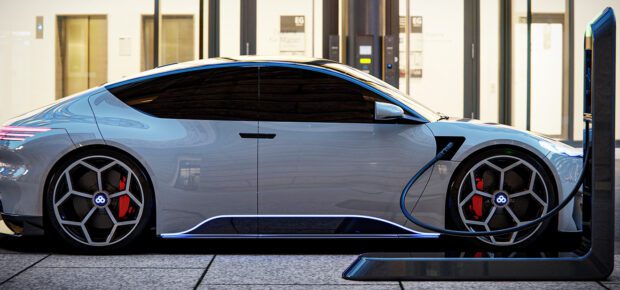October 24, 2022
If you had a crystal ball, and could peer into the future, you’d probably see electric vehicles (EV). Millions of them.
According to the International Energy Agency, electric vehicles accounted for 9 percent of sales globally in 2021.
But that’s going to change. Several automakers have announced plans to go fully electric by 2030, with most others announcing plans to phase out internal combustion engines over a longer timeframe.
To propel the sale of EVs, lots of other changes may have to occur – better battery technology, faster charging batteries and more charging stations.
Powering Sustainability
Transportation is widely seen as one of the top five industries that will be most impacted by technology in 2023 – cited by 39% of technology leaders surveyed respondents in “The Impact of Technology in 2023 and Beyond: an IEEE Global Study.”
Transportation accounts for roughly one-quarter of global greenhouse gas emissions. The transition from internal combustion engines to electric vehicles is critical to avoiding the worst effects of climate change.
And it’s not just automakers that are eyeing technologies to improve sustainability; 94% of respondents in the same study agree their company has prioritized sustainability goals for 2023 and beyond, so any technologies they implement are required to be energy-efficient and help shrink their carbon footprint.
Want the inside scoop on technology in 2023? Check out this interactive experience.
From the Grid to the Gas Station
The rise of EVs will also bring about changes to the infrastructure all around us. Governments across the world are pushing to build more EV charging stations. India, for example, is working on a plan to add an EV charging station for every 40 to 60 kilometers of national highway by 2023, said Inderpreet Kaur, an IEEE Senior Member. In the U.S., the Inflation Reduction Act contains provisions for tax credits to encourage an EV charging infrastructure buildout.
But several roadblocks remain on the path to mass electrification of transportation. In the U.S. at least, most people charge their vehicles at home, or at the office while they are at work.
Homes with garages and driveways may have an easy time installing a charging station. But residents in older homes, or drivers that live in cities or areas where on-street parking predominates don’t have such opportunities.
And in colder climates, a charging station also serves to “condition” EV batteries, making them more efficient when temperatures plunge. A limited number of charging stations – especially in shopping center parking lots or office complexes – may exacerbate concerns about range anxiety (a fear of running out of power with no station to recharge nearby).
IEEE Member Kyrie Baker points out that simultaneous charging of a large number of EVs can exacerbate peak electricity demand and strain existing infrastructure.
“Smart charging strategies and ways to coordinate EV charging can help mitigate some of the issues with power line and transformer overloading,” Baker said.
To resolve the stress, operators could use machine learning techniques to design pricing structures that encourage off-peak charging.
In the end, your crystal ball may see lots of electric cars, but there’s a whole lot of changes that go along with it.
“The Impact of Technology in 2023 and Beyond: an IEEE Global Study” surveyed 350 CIOs, CTOs, IT directors and other technology leaders in the U.S., China, U.K., India and Brazil at organizations with more than 1,000 employees across multiple industry sectors including banking and financial services, consumer goods, education, electronics, engineering, energy, government, healthcare, insurance, retail, technology and telecommunications.
Learn more: What does it take to build a smart charging system that allows users to fuel their electric vehicles cleanly, inexpensively, and without excess stress on the electrical grid? Research from the IEEE Power and Energy Society explores that question.






 Meaningful Momentum or Running in Place?
Meaningful Momentum or Running in Place? AI Through Our Ages
AI Through Our Ages Liquid Infrastructure: Our Planet's Most Precious Resource
Liquid Infrastructure: Our Planet's Most Precious Resource The Impact of Technology in 2025
The Impact of Technology in 2025 Quantum and AI: Safeguards or Threats to Cybersecurity?
Quantum and AI: Safeguards or Threats to Cybersecurity? Why AI Can't Live Without Us
Why AI Can't Live Without Us Bits, Bytes, Buildings and Bridges: Digital-Driven Infrastructure
Bits, Bytes, Buildings and Bridges: Digital-Driven Infrastructure Impact of Technology in 2024
Impact of Technology in 2024 Emerging AI Cybersecurity Challenges and Solutions
Emerging AI Cybersecurity Challenges and Solutions The Skies are Unlimited
The Skies are Unlimited Smart Cities 2030: How Tech is Reshaping Urbanscapes
Smart Cities 2030: How Tech is Reshaping Urbanscapes Impact of Technology 2023
Impact of Technology 2023 Cybersecurity for Life-Changing Innovations
Cybersecurity for Life-Changing Innovations Smarter Wearables Healthier Life
Smarter Wearables Healthier Life Infrastructure In Motion
Infrastructure In Motion The Impact of Tech in 2022 and Beyond
The Impact of Tech in 2022 and Beyond Cybersecurity, Technology and Protecting Our World
Cybersecurity, Technology and Protecting Our World How Technology Helps us Understand Our Health and Wellness
How Technology Helps us Understand Our Health and Wellness The Resilience of Humanity
The Resilience of Humanity Harnessing and Sustaining our Natural Resources
Harnessing and Sustaining our Natural Resources Creating Healthy Spaces Through Technology
Creating Healthy Spaces Through Technology Exceptional Infrastructure Challenges, Technology and Humanity
Exceptional Infrastructure Challenges, Technology and Humanity The Global Impact of IEEE's 802 Standards
The Global Impact of IEEE's 802 Standards Scenes of our Cyber Lives: The Security Threats and Technology Solutions Protecting Us
Scenes of our Cyber Lives: The Security Threats and Technology Solutions Protecting Us How Millennial Parents are Embracing Health and Wellness Technologies for Their Generation Alpha Kids
How Millennial Parents are Embracing Health and Wellness Technologies for Their Generation Alpha Kids Space Exploration, Technology and Our Lives
Space Exploration, Technology and Our Lives Global Innovation and the Environment
Global Innovation and the Environment How Technology, Privacy and Security are Changing Each Other (And Us)
How Technology, Privacy and Security are Changing Each Other (And Us) Find us in booth 31506, LVCC South Hall 3 and experience the Technology Moon Walk
Find us in booth 31506, LVCC South Hall 3 and experience the Technology Moon Walk Virtual and Mixed Reality
Virtual and Mixed Reality How Robots are Improving our Health
How Robots are Improving our Health IEEE Experts and the Robots They are Teaching
IEEE Experts and the Robots They are Teaching See how millennial parents around the world see AI impacting the lives of their tech-infused offspring
See how millennial parents around the world see AI impacting the lives of their tech-infused offspring Take the journey from farm to table and learn how IoT will help us reach the rising demand for food production
Take the journey from farm to table and learn how IoT will help us reach the rising demand for food production Watch technical experts discuss the latest cyber threats
Watch technical experts discuss the latest cyber threats Explore how researchers, teachers, explorers, healthcare and medical professionals use immersive technologies
Explore how researchers, teachers, explorers, healthcare and medical professionals use immersive technologies Follow the timeline to see how Generation AI will be impacted by technology
Follow the timeline to see how Generation AI will be impacted by technology Learn how your IoT data can be used by experiencing a day in a connected life
Learn how your IoT data can be used by experiencing a day in a connected life Listen to technical experts discuss the biggest security threats today
Listen to technical experts discuss the biggest security threats today See how tech has influenced and evolved with the Games
See how tech has influenced and evolved with the Games Enter our virtual home to explore the IoT (Internet of Things) technologies
Enter our virtual home to explore the IoT (Internet of Things) technologies Explore an interactive map showcasing exciting innovations in robotics
Explore an interactive map showcasing exciting innovations in robotics Interactively explore A.I. in recent Hollywood movies
Interactively explore A.I. in recent Hollywood movies Get immersed in technologies that will improve patients' lives
Get immersed in technologies that will improve patients' lives